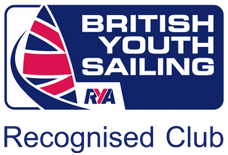SIMPLE OVERVIEW OF THE RULES OF DINGHY RACING FOR CLUB SAILORS
(REFERENCE RYA RULES 2021-24)
Revision 1
15/1/24.
This is a guide only and the RYA rules take precedence. The rules are available on the internet and explanation videos are readily available on YouTube.
BOATS ON OPPOSITE TACKS
A boat on port shall give way to a boat on starboard including at the windward mark. The only exception is within the 3 boat length zone (the zone) around a buoy where ‘mark room’ applies. Note mark room does not apply at the windward mark or the marks defining the start line where the port starboard rule still applies. See below.
So for example a boat close hauled on port shall give way to a boat running on starboard tack.
Generally once the port boat has completed its tack an overtaking boat on starboard must then keep clear of her - ie head higher to avoid as necessary.
Within 3 boats lengths of the windward mark a boat tacking from port onto starboard must not force an incoming starboard boat to change course above close hauled to avoid.
The boat tacking must complete her tack and the incoming starboard boat must have time to avoid but if the starboard boat has to then sail higher but not above close hauled that is fine.
BOATS ON THE SAME TACK
Boats sailing proper course (quickest route around a race course) the boat to windward gives way to the boat to leeward again except within the zone.
So for example a boat running on port tack shall give way to a boat reaching on port tack.
Luffing - after race start A boat to leeward can sail higher than her proper course (luff) to defend against a boat overtaking to windward except within the zone. However generally a boat overtaking to leeward cannot luff but she can sail her proper course.
Asymmetric boats zig zag downwind so their proper course will be much higher than the proper course of a conventional boat going in the same general direction so the conventional boat may still have to give way.
Luffing - before race start the leeward boat can always luff the boat above irrespective of how the overlap was gained.
So even if she came from behind and is overtaking she can luff
MARK ROOM
The room to round a mark rules apply to all buoys except the windward mark and the marks/boats defining the start line at the start. The rules do apply to the marks/boats defining the start line on all subsequent laps.
A boat inside and overlapping another boat (bow ahead of other boats stern) when the first boats bow reaches three boat lengths from the buoy is entitled to room to round the mark.
Doesn’t matter what tack the boats are on and there may be several boats overlapping each other so the outer boat may have to give reasonable room for inside boats to round the mark. Note in all cases the boats that are given room must sail their proper course. Also if there is doubt whether an overlap was established the onus of proof is with the boat requesting room.
OBSTRUCTIONS
A boat can ask another boat to give her room to pass or avoid an obstruction.
At Llandegfedd the obstruction will normally be the shore line. So a boat may call for ‘room to tack’ to avoid the shore.
PROPULSION
Sculling, pumping, rocking and excessive tacking and gybing (where not necessary to follow the course or react to wind shifts) are not allowed. The rules do allow for reasonable movement of a boat including roll tacking, providing the boat leaves the tack no quicker than it entered, and quickly pulling on a mainsail to pop an inverted batten and sculling to recover from being stuck head to wind.
PENALTIES
At Llandegfedd a rule infringement including touching a mark can be exonerated by promptly completing one 360 degree turn including a tack and gybe. A Boat that does not take a penalty turn after a rule infringement risks protest by another competitor and this could result in disqualification so if a rule is infringed a penalty turn is recommended.
Similarly if a boat accidentally rounds a mark the wrong way a 360 degree turn is all that is required. In this case if a penalty turn hasn’t been completed the offending boat will be given a time or position penalty rather than be disqualified.
Clearly some infringements will always result in disqualification including missing a mark completely, starting early, unsporting behaviour, causing a collision etc.
AVOIDING COLLISIONS AND ROOM TO KEEP CLEAR
There is a general obligation to avoid a collision and to allow another boat room to keep clear.
So for example a boat cannot luff another boat so aggressively that contact is inevitable. Similarly a luff must stop if both boats are effectively locked together. Ie the windward boat can do nothing to avoid contact.
PROTESTS
Where potential rule infringements are not resolved on the water Llandegfedd has a simplified protest process that can be utilised. The protester must inform the OOD of the intention to protest before the OOD leaves the club on the day of the incident and must follow up with email detailing the protest all as LLSC Sailing Instructions.
COMMUNICATION ON THE WATER
Communicating clearly with other boats can be helpful and can help to avoid collisions. Common calls include starboard, windward boat keep clear, room to tack please ( at obstruction), hold your course (where a boat on starboard is happy to dip behind a port boat), water at the mark please (room to round a mark), no water (where lead boat doesn’t feel an overlap was established), protest etc




